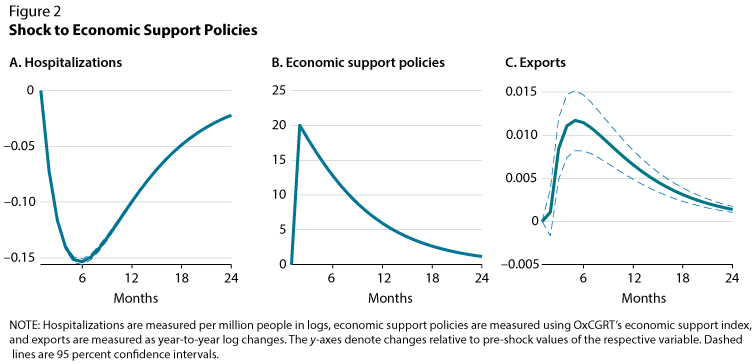
Figure 1 plots how COVID-19's spread and economic activity responded to a sharp tightening of government health containment policies. We consider a 20-point increase of the health and containment index from the Oxford COVID-19 Government Response Tracker (OxCGRT), which captures policies such as mask mandates, workplace and school closings, and travel restrictions, among others.2 For context, the average value of this index across states from March-November 2020 was 49, remaining between 33 and 65 in most states over this period; so, a 20-point rise is a large increase in health containment policies. Panel B of Figure 1 plots the tightening of the health containment policies we consider.
Panel A of Figure 1 shows that a 20-point increase in health containment policies reduces COVID-19 hospitalizations by 60 percent within a few months. This result implies that the combination of containment policies implemented successfully reduced the spread of the virus in 2020.
While health containment policies limited COVID-19's spread, they were nevertheless costly. Panel C of Figure 1 shows that a 20-point increase in health containment policies reduces exports, our measure of economic activity, by approximately 7 percent in the month after their implementation. But the response is short lived: Exports rapidly recover and within a year are unaffected by the initial policy.
However, health containment policies were not implemented in isolation: State governments often simultaneously introduced economic support policies to mitigate the economic cost of the virus. Examples of these policies range from expanding unemployment insurance to enacting moratoriums on rent or mortgage payments. OxCGRT's economic support index captures the intensity of these policies.

Figure 2 plots the responses of COVID-19's spread and economic activity to a large (20 point) increase in the economic support index. The change in economic support policies is plotted in Panel B.
Panel A of Figure 2 shows that a 20-point increase in the economic support index reduces COVID-19 hospitalizations by 15 percent within five months. This finding suggests that financial benefits to encourage people to remain at home and replace lost labor income were also effective in reducing the spread of COVID-19.
Panel C of Figure 2 shows that economic policies lead to a 1 percent increase in exports six months after implementation. Thus, these policies succeeded in both reducing COVID-19's spread and stimulating the economy. Economic support to encourage contact-intensive sectors to temporarily shut down might have led to increased economic activity in less-contact-intensive sectors such as those that produce goods more likely to be exported.
In conclusion, our recent working paper allows us to identify how different types of government policies implemented throughout the pandemic have affected the spread of COVID-19 and economic activity. We find that health and containment policies greatly reduced the spread of COVID-19 but at the cost of reducing economic activity. However, economic support policies successfully complemented these policies, further reducing the transmission of COVID-19 while helping to stimulate the economy.
Notes
1 Famiglietti, Matthew and Leibovici, Fernando. "The Economic and Epidemiological Impact of COVID-19 and Government Policies: Part 1." Federal Reserve Bank of St. Louis Economic Synopses, 2021, No. 14.; https://research.stlouisfed.org/publications/economic-synopses/2021/07/01/the-economic-and-epidemiological-impact-of-covid-19-and-government-policies-part-1.
2 See https://www.bsg.ox.ac.uk/research/research-projects/covid-19-government-response-tracker.
© 2021, Federal Reserve Bank of St. Louis. The views expressed are those of the author(s) and do not necessarily reflect official positions of the Federal Reserve Bank of St. Louis or the Federal Reserve System
More Articles
- A Reminder From the White House: Prepare for New Variants As We Work to Keep Ourselves Protected Against COVID-19
- COVID-19 Vaccine Breakthrough Case Investigation and CDC Reporting: Hospitalized or Fatal Breakthrough Cases Reported as of May 10, 2021
- GAO Report: Maternal Mortality and Morbidity: Additional Efforts Needed to Assess Program Data for Rural and Underserved Areas
- Frequently Asked Questions about COVID-19 Vaccination Updated Jan. 25, 2021; Content source: National Center for Immunization and Respiratory Diseases (NCIRD), Vaccines Frequently Asked Questions
- How are States Prioritizing Who Will Get the COVID-19 Vaccine First? CDC’s Advisory Committee on Immunization Practices (ACIP) Released an Interim Recommendation For the Highest Priority Group
- The Effects of Large Group Meetings on the Spread of COVID-19: The Case of Trump Rallies, Stanford Institute for Economic Policy Research
- FactCheck.org: Q&A on Trump’s COVID-19 Diagnosis
- Covid 19 Hearing Sept 16th: CDC Director Dr. Redfield Testified on the Latest Coronavirus Response Efforts
- GAO: COVID-19 Complicates Already Challenged FDA Foreign Inspection Program; It Could Be 2 to 3 Years Before New Staff Are Experienced Enough To Conduct Foreign Inspection
- "I am Dr. Rick Bright, a career public servant and a scientist who has spent 25 years of my career focused on addressing pandemic outbreaks"






